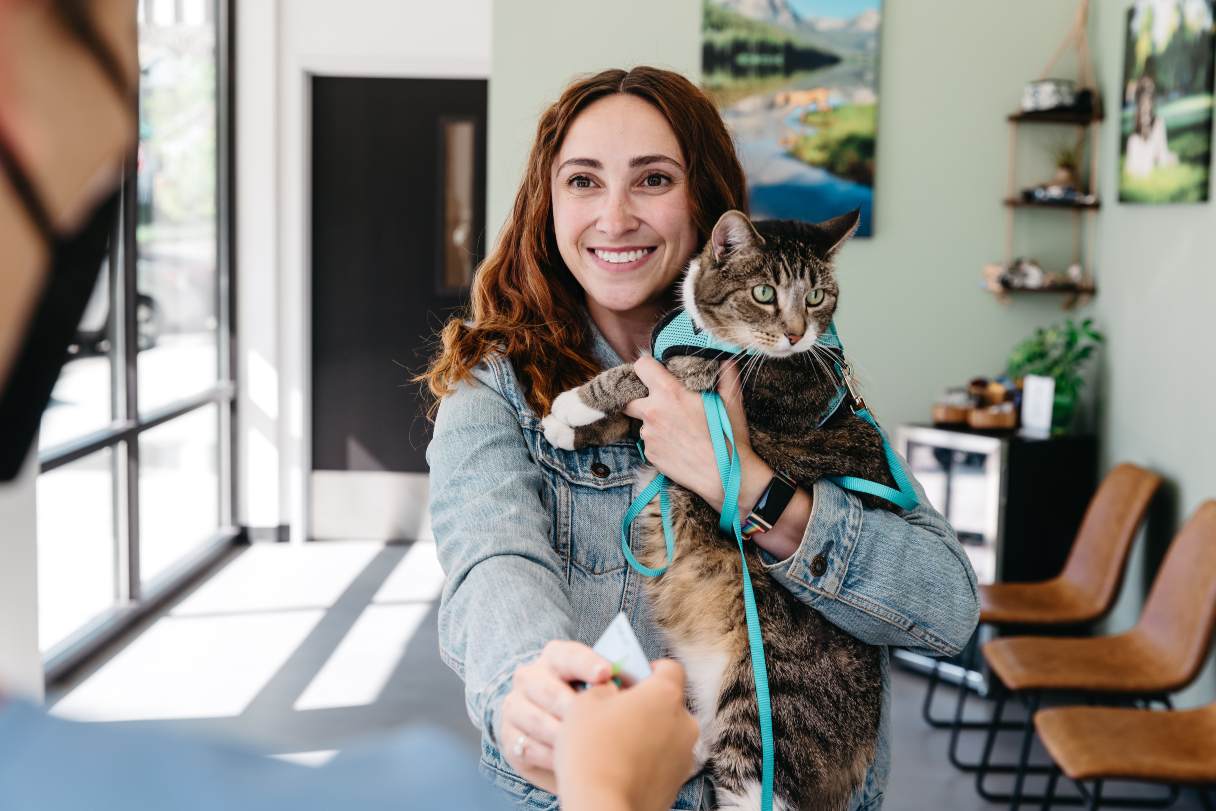Your pet’s health is important, but routine veterinary costs can add up over their lifetime. And unforeseen illnesses and injuries leave many pet parents in anguish over their inability to afford potentially lifesaving treatments. Pet insurance can help make sure your pet can always get the healthcare they need.
What Is Pet Insurance?
While pets are generally thought of more as family members than as property, pet insurance — also referred to as pet health insurance — works more like personal property insurance than human health insurance. This is because pet insurance will reimburse you for the costs of veterinary care that are covered by your plan if your pet becomes sick or injured.
Some types of coverage also include routine pet healthcare, such as vaccinations and health screenings. In any case, you pay up front for your pet’s care, submit a claim and your pet insurance company then reimburses you for covered costs.
As an industry, pet health insurance has experienced significant growth in recent years. In the United States alone, pet coverage has more than doubled since 2019. The number of insured cats has increased from fewer than half a million cats to over 1.2 million, while the number of insured dogs has risen from just over 2 million to 4.5 million by the end of 2023.1
What’s Covered by Pet Insurance?
Pet insurance companies typically offer different types of health coverage. Although these vary from one provider to the next, they generally include:
- Accident-only coverage. Accident-only policies cover emergency care if your pet gets hurt in an accident.
- Accident and illness. This is more comprehensive coverage that reimburses you for diagnosing and treating unexpected illnesses and diseases in addition to accidental injury.
- Wellness coverage. Also sometimes called routine or preventive care coverage, this is typically an add-on plan that covers routine healthcare. Depending on the policy, this may include vaccinations, routine blood tests and dental care.
It’s important to be aware that having pet insurance doesn’t guarantee that your pet’s care will automatically be covered. Pet insurance policies commonly exclude coverage for preexisting conditions.
In addition, pet insurance typically doesn't cover anything related to pregnancy or birth. And most accident and illness policies don’t cover routine healthcare — this type of coverage usually requires an additional payment for wellness coverage. Many add-on policies may not cover such routine care as flea, tick or heartworm prevention, nail trimming or even spaying or neutering.
It’s important to read the fine print when reviewing a pet insurance policy to make sure you know exactly what kinds of treatment and care are covered.
Pet Insurance Cost for Cats and Dogs
Several factors determine the cost of pet insurance premiums, including your location, the typical veterinary fees in your area and your pet’s breed, age and gender.
Pet insurance cost for dogs
Here are the national average costs* of pet insurance premiums for dogs in the U.S. according to CareCredit's 2024 Average Procedural Cost Study:2
| Type of coverage | Average monthly premium |
|---|---|
| Accident-only | $15 to $25 |
| Accident and illness | $30 to $50 |
| Wellness plan | $20 to $40 |
Pet insurance cost for cats
Here are the national average costs* of pet insurance premiums in the U.S. for cats based on the same study:2
| Type of coverage | Average monthly premium |
|---|---|
| Accident-only | $10 to $20 |
| Accident and illness | $20 to $40 |
| Wellness plan | $15 to $30 |
Pet insurance is usually paid through monthly or annual premiums. Some pet insurance companies also offer plans with deductibles, which is an annual amount you’ll have to pay out of pocket before your coverage kicks in. The higher the deductible, the lower your premiums are likely to be, and vice versa.
How Does Pet Insurance Work?
Using pet insurance is fairly straightforward and typically works something like this:
- Take your dog or cat to the vet and receive treatment for a covered condition.
- Pay the vet up front for the treatment.
- File a claim with your insurance company.
- Receive reimbursement via check or direct deposit for all or some of what you paid for your pet’s care.
Some policies have a copay or coinsurance amount, which is an amount you agree to pay that won’t be reimbursed. Typically, this is 20% of the cost of treatment, which means the insurance company reimburses you for the remaining 80%. Some pet insurance policies, however, pay up to 90% or even 100% of the cost of treatment.
Rather than coinsurance, some pet insurance companies instead use a benefit schedule that has a set amount of reimbursement based on the specific illness or injury, as well as the level of coverage provided by your policy.
You should also be aware that pet insurance policies usually include a waiting period between the time you sign up for insurance and the time you can start using it. This varies from one company to another but is usually between 10 and 30 days. If your pet gets injured or starts showing signs of illness during the waiting period, their treatment won’t be eligible for reimbursement.
Also, if you change plans or providers, your pet will likely have to start over with a new waiting period, and any medical condition your pet was treated for under your old plan may be excluded as a preexisting condition under the new plan.
Some pet insurance plans may also have maximum payout limits for long-term illnesses or chronic conditions. It’s important to read the details of your policy carefully so you won’t be caught off guard when you’re making important health decisions for your pet.
Benefits of Pet Insurance
Why should you purchase pet insurance for your dog or cat? Here are a few of the most significant benefits:
- Financial protection. Pet insurance can help ensure that a catastrophic pet injury or illness won’t break your bank account, and the right plan can also help make non-emergency care more affordable.
- Ability to provide the best care. Most pet insurance companies, like Pets Best, allow you to choose your own vet instead of having to stay within a network. They also typically cover 24-hour emergency clinics and expensive diagnostic procedures like MRIs that might otherwise be unaffordable.3
- Peace of mind. Sadly, many pets end up euthanized simply because their caregivers can’t afford veterinary treatments that could save or extend their lives. Pet insurance can help prevent you from ever being in that position, allowing you the peace of mind that comes with knowing you can say yes to the care your beloved companion needs.
Choosing the Right Pet Insurance
Choosing the right coverage involves a lot of different factors and decisions. As you shop for pet insurance and research multiple providers, here are some things you should consider:
Your pet’s breed
Purebred dogs and cats often have more health predispositions than mixed breeds, making them more expensive to insure. Additionally, some breeds have more frequent or severe health issues, which can further increase the insurance premium for particular breeds.
Before choosing pet insurance, thoroughly research your pet’s breed and talk to your vet about any predispositions to diseases or other health issues.
Your pet’s age
Most pet insurance doesn’t cover puppies or kittens under 8 weeks old. And as pets age, some insurance companies raise premiums, while others may refuse to offer new policies to senior pets altogether. However, once your younger pet is insured, you can usually maintain their policy throughout their life. That's why it’s best to insure your pet once they reach 8 weeks of age or while they’re in the prime of life.
As you shop for insurance, consider your pet’s age and carefully review policies to make sure they’ll continue to receive full coverage into their twilight years.
Your pet’s current health and history
If your pet has a preexisting condition at the time you open a new insurance policy for them, it likely won’t be covered. Some providers, however, do include preexisting conditions as part of their coverage, though they may have specific rules regarding what can be covered.
If your pet already has any health conditions, look for a company that covers preexisting conditions and carefully review their policy to find out for certain whether your pet’s condition is covered.
Making an Informed Choice
As you shop for pet insurance, first write down your questions and then consult with each insurance provider you’re considering to be sure each question is answered. You should also ask to review the policies in advance before enrolling. When you do, read carefully so you’ll be certain what is and isn’t covered, as well as how much you can expect to pay out of pocket for any treatments or procedures.
Pet insurance that reimburses you for veterinary expenses can not only save you money over your pet’s lifetime but could also make all the difference in life-or-death situations. Knowing you’ll be able to pay for any lifesaving care your pet might need someday can provide peace of mind that’s priceless.
CareCredit Credit Card Financing for Pets
Taking good care of your pet's well-being from nose to tail is essential. Make sure to stay up to date on their regular checkups at the vet to help keep your pet happy and healthy for a lifetime of love. You can use your CareCredit credit card for pet care throughout the year for routine veterinary services as well as emergencies and surgeries.** Use our Acceptance Locator to find a veterinarian near you that accepts CareCredit.
CareCredit is there for you and your pet every step of the way. Continue your wellness journey by downloading the CareCredit Mobile App to manage your account, find a provider on the go and easily access the Well U blog for more great articles, podcasts and videos.
In addition to pet care, you can also use your CareCredit credit card for dentistry, cosmetic, vision, hearing, health systems, dermatology, pharmacy purchases, spa treatments and so much more within the CareCredit network. How will you invest in your health and wellness next?
Expert Reviewer
Dr. Fiona Lee, D.V.M.
As the daughter of a veterinarian, Dr. Fiona Lee grew up playing in kennels with bandage material and tongue depressors. This eventually turned into a passion for animals and veterinary medicine. Dr. Fiona now serves as the Director of Medical Standards at Habitat Veterinary Hospital in Boise, Idaho. After completing her undergraduate degree in biology and chemistry at Willamette University in Salem, Oregon, Dr. Fiona received her veterinary degree from Colorado State University in Fort Collins, Colorado in 2007.
Author Bio
Jean Marie Bauhaus is a freelance writer and novelist who has been writing pet content since 2013. Her work has appeared on Forbes.com, Hill's Pet, Chewy, AKC.org and more.







